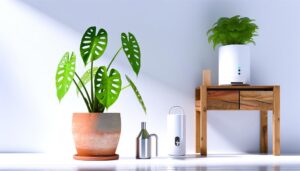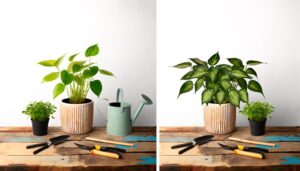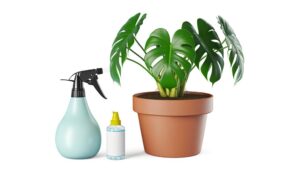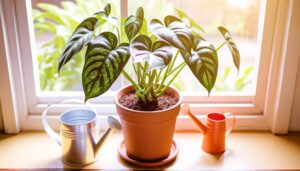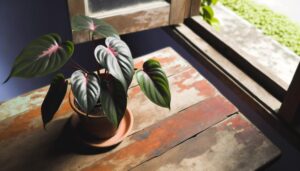Imperial Red Philodendron Care: Essential Tips and Tricks!
The Imperial Red Philodendron flourishes in bright indirect sunlight, in a well-drained, fertile soil rich in organic matter. Regular watering is crucial when the top inches of the soil dry out, overwatering can lead to root rot.
This houseplant tolerates temperatures between 65-75 Fahrenheit and prefers a humidity level of 60-75%. Fertilization every 4-6 weeks with a nitrogen-rich solution during growth periods is recommended.
Regular inspection and prompt response to symptoms of pests or diseases will maintain the plant’s essentiality. For best results, understanding the specific care requirements of this splendid specimen is crucial.
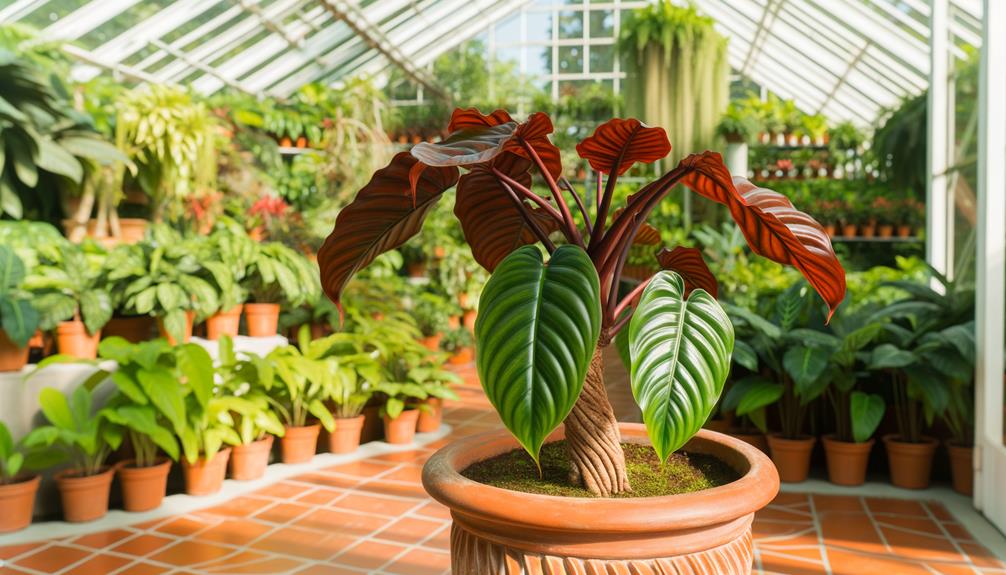
Key Takeaways
- Imperial Red Philodendrons thrive in bright, indirect sunlight and temperatures between 65 to 75 degrees Fahrenheit.
- Water the plant when the top 1-2 inches of soil are dry, but avoid waterlogging the soil to prevent root rot.
- This plant prefers well-drained, nutrient-rich soil with a pH between 6.0 and 7.0, with regular repotting every 2-3 years.
- Maintain a humidity level of 60-75%, using room humidifiers in dry environments and misting with distilled water.
- Fertilize every 4-6 weeks during the growing season with a balanced, water-soluble fertilizer high in nitrogen.
Understanding the Imperial Red Philodendron
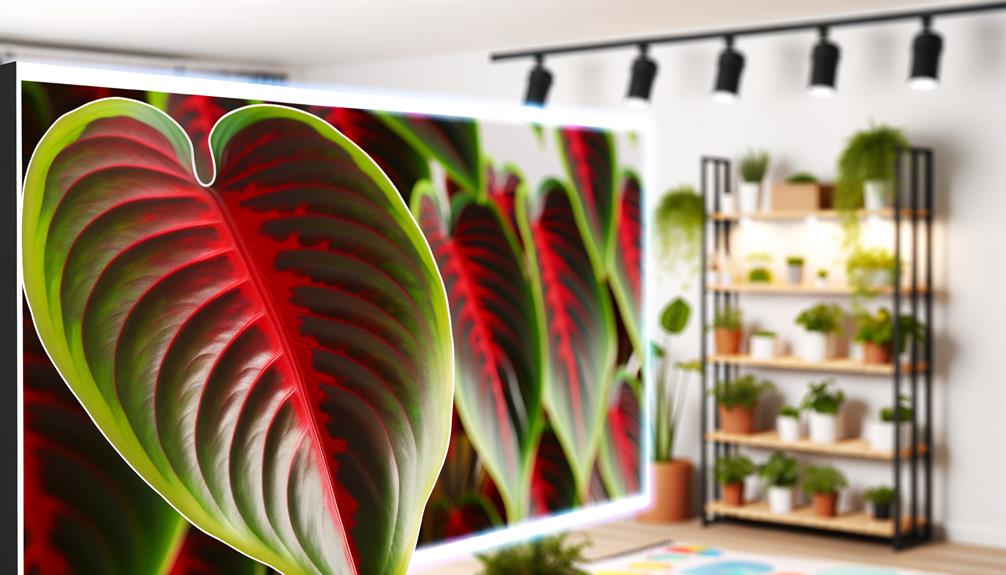
The Imperial Red Philodendron’s intricate beauty, characterized by its vibrant red and deep burgundy foliage, belies the nuanced understanding needed for its best growth and care.
This tropical plant, native to South America, belongs to the Araceae family. It thrives in a warm, humid environment, reflecting its natural rainforest habitat. The plant requires well-draining, fertile soil, rich in organic matter. Avoid overwatering as it can lead to root rot. A balanced, slow-release fertilizer, applied during the growing season, will support its lush growth.
It’s important to keep the plant away from direct drafts and sudden temperature fluctuations. While the Imperial Red Philodendron is a robust variety, it’s susceptible to common houseplant pests such as mealybugs and spider mites. Regular inspections and early intervention are crucial for maintaining its health.
Ideal Lighting Conditions
Imperial Red Philodendron’s vibrant foliage thrives most in a setting with bright, indirect sunlight, reflecting its tropical origins. Direct sunlight, especially intense afternoon rays, can cause leaf burn or discoloration, detracting from this plant’s aesthetic appeal.
On the other hand, insufficient light can lead to leggy growth, with large distances between leaves and a less dense, lush appearance.
Placement of this plant should be strategic, such as near an east or north-facing window, where it can receive gentle morning or late afternoon sun. Using a light meter can aid in achieving ideal light levels, which typically range from 200 to 400 foot-candles.
For those committed to providing top-notch care, monitoring and adjusting the plant’s light exposure is a key aspect of maintaining its vibrant, lustrous appearance.
Watering Requirements
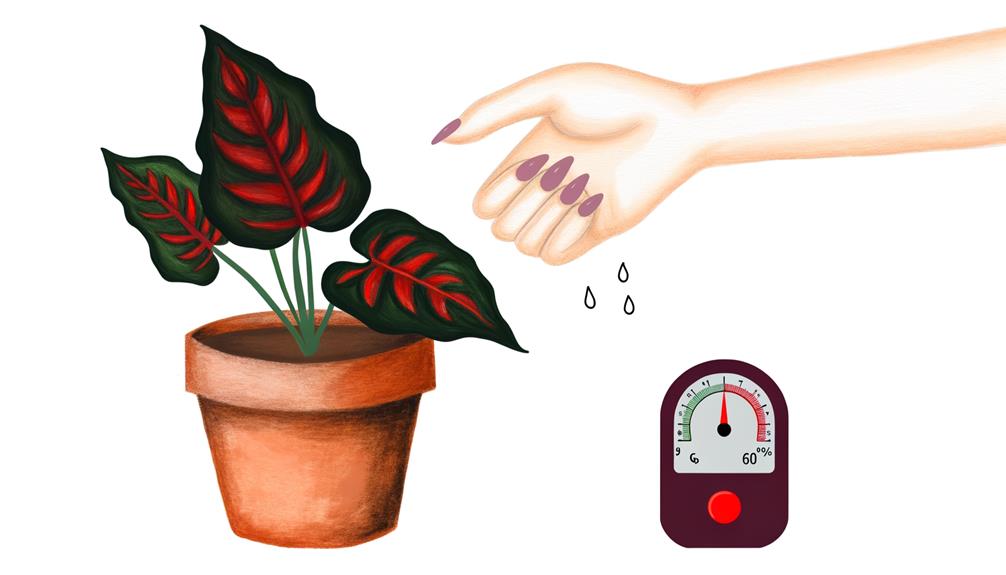
Appropriate hydration plays a crucial role in maintaining the health and vibrancy of the Imperial Red Philodendron.
To achieve peak growth, understanding the correct watering techniques, along with recognizing signs of underwatering, is essential.
This section will elucidate these aspects, providing a scientific and detailed guide to watering this particular species.
Optimal Watering Techniques
In understanding the best watering techniques for the Imperial Red Philodendron, it is important to observe that this species prefers its soil to be consistently moist but not waterlogged, a balance that can be achieved through careful and regular watering practices.
A thorough watering is recommended when the top 1-2 inches of soil feel dry to the touch. This approach encourages the plant’s roots to grow deeper and ensures that water reaches all parts of the root system. Over-watering can lead to root rot, a common issue for these plants. Hence, use well-draining soil and pots with sufficient drainage holes.
A moisture meter can also be a valuable tool in maintaining the right moisture levels, aiding in the provision of ideal care for this exquisite species.
Recognizing Underwatering Signs
While maintaining the perfect moisture levels is crucial for the Imperial Red Philodendron’s growth, it is equally important to be able to identify signs of underwatering, an issue that can seriously hinder the plant’s health and development.
Underwatering signs are usually visible in the plant’s physical appearance. These include:
- Leaf Wilting: This is characterized by the leaves drooping, despite the plant not being due for watering.
- Yellow Leaves: The leaves may turn yellow, and this is especially noticeable in the older, lower leaves.
- Slow Growth: The plant may exhibit stunted growth or no growth at all, even during the growing season.
- Dry Soil: The soil will feel dry to the touch and may pull away from the sides of the pot.
Recognizing these signs early can help ensure ideal care for the Imperial Red Philodendron.
Soil and Potting Preferences
Frequently, the Imperial Red Philodendron shows its most vibrant growth in well-drained, nutrient-rich soil, ideally housed in a spacious container that allows for the best root expansion. This species thrives in a peat moss-based potting mix with a pH between 6.0 and 7.0, which helps in nutrient absorption.
Adding perlite or coarse sand improves drainage while retaining enough moisture. A container with ample drainage holes is vital to prevent water-logging, a condition harmful to root health. Regular repotting every 2-3 years allows examination and removal of dead or decaying roots, promoting healthy expansion.
For those striving to provide the best care, understanding these soil and potting preferences is essential in creating an environment conducive to the plant’s vigorous growth.
Temperature and Humidity Needs
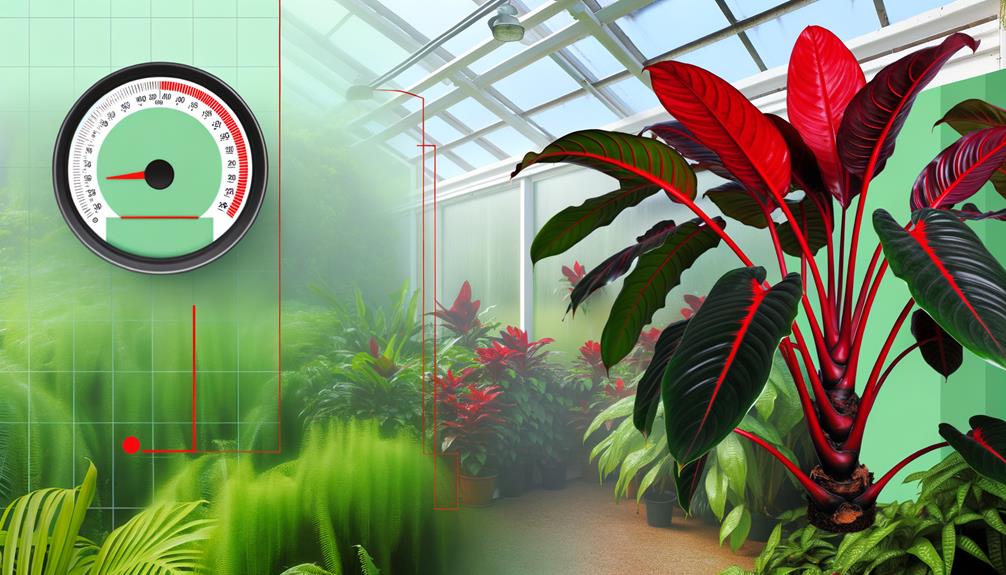
The Imperial Red Philodendron exhibits specific temperature and humidity requirements to guarantee its healthy growth.
An understanding of its ideal temperature range, from the minimum to the maximum, is fundamental to creating a best-suited environment for this plant species.
Similarly, the plant’s humidity needs are critical, as too little or too much moisture in the air can greatly impact its development and overall health.
Ideal Temperature Range
In the field of horticulture, understanding the temperature and humidity needs for the Imperial Red Philodendron is crucial to its thriving growth. It prefers a warm environment with temperatures ranging from 65 to 75 degrees Fahrenheit (18-24 degrees Celsius) and a humidity level of 60-75%.
There are four critical factors to take into account:
- Thermal Tolerance: The plant can adapt to slight fluctuations outside the ideal range, but prolonged exposure to extreme temperatures can lead to stress.
- Seasonal Variations: Temperatures can be slightly lower in winter (above 60 degrees) without affecting the plant’s health.
- Indoor Heating: Be cautious of artificial heat sources, as they can dry out the air and harm the plant.
- Acclimatization: Plants need time to adjust to changes in temperature, so gradual alterations are preferable.
Humidity Requirements
Highly adjustable to indoor settings, Imperial Red Philodendron thrives best with a relative moisture level of 60-75%, although it can tolerate levels as low as 50%.
This plant’s epiphytic nature makes it very sensitive to changes in moisture, as it depends on surrounding dampness for its nutrient absorption.
To maintain prime moisture levels, daily misting with distilled, room-temperature water is suggested. However, avoid creating excessively wet conditions, as this promotes fungal growth.
In arid environments or during winter months when indoor heating might decrease moisture levels, the use of a room humidifier can improve plant health.
Monitoring moisture levels using a hygrometer can guarantee the environment stays within the plant’s preferred range, thereby promoting vibrant growth and reducing pressure on the plant.
Feeding and Fertilizing Schedule
Peak growth and vivid color in Imperial Red Philodendrons are achieved through a carefully planned feeding and fertilizing schedule that considers the specific nutritional requirements of this tropical plant species.
Here are critical elements of their nutritional schedule:
- Timing: Fertilize every 4-6 weeks during the growing season (spring and summer), and less frequently during dormant periods (fall and winter).
- Type of Fertilizer: Use a balanced, water-soluble fertilizer with macro and micronutrients, specifically high in nitrogen content to promote lush growth.
- Application: Apply the fertilizer solution to moist soil to prevent root burn.
- Quantity: Over-fertilizing can harm the plant. A half-strength solution is usually sufficient.
Proper adherence to these principles ensures a robust and vibrant Imperial Red Philodendron, promoting a sense of fulfillment and service to fellow nature enthusiasts.
Common Pests and Diseases
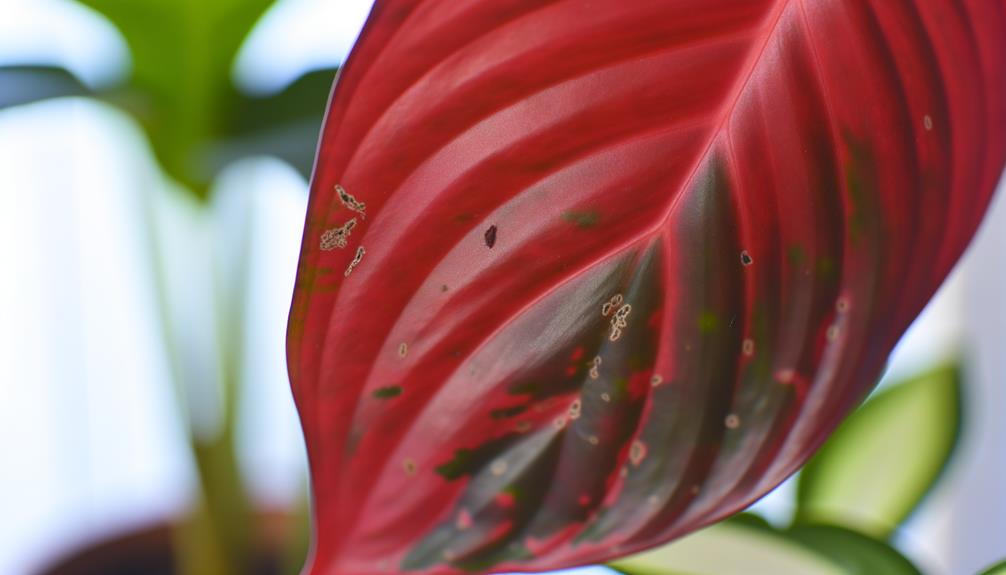
Imperial Red Philodendrons, while known for their resilience, can fall prey to a variety of pests and diseases that can hinder their growth and affect their overall health. The most common culprits are mealybugs, aphids, and root rot disease.
| Pests/Disease | Control Measures |
|---|---|
| Mealybugs | Apply insecticidal soap or neem oil. |
| Aphids | Use a strong water spray to dislodge them, followed by insecticidal soap. |
| Root Rot | Ensure proper drainage, avoid overwatering, and consider a fungicide if necessary. |
These pests and diseases primarily affect the plant’s essentiality, causing stunted growth and in severe cases, plant death. Regular inspection, early detection and prompt action can guarantee your Imperial Red Philodendrons continue to thrive and serve their purpose of bringing beauty and tranquility to your space.
Imperial Philodendron Care
- Light: Bright, indirect sunlight. Avoid direct sunlight to prevent leaf burn.
- Watering: Water when the top inch of soil is dry. Ensure good drainage to avoid root rot.
- Humidity: Prefers high humidity (60-80%). Use a humidifier or mist the leaves regularly.
- Temperature: Thrives in temperatures between 65-80°F (18-27°C). Keep away from cold drafts.
- Soil: Use well-draining, aroid mix soil with organic matter. A mix of potting soil, perlite, and orchid bark is ideal.
- Fertilization: Feed monthly during the growing season (spring and summer) with a balanced liquid fertilizer.
- Pruning: Remove yellow or damaged leaves to encourage new growth.
- Repotting: Repot every 2-3 years or when the plant outgrows its pot, usually in spring.
- Pests: Watch for common pests like spider mites, aphids, and mealybugs. Treat with insecticidal soap if needed.
- Propagation: Propagate through stem cuttings. Place the cuttings in water or moist soil until roots develop.
By following these care tips, your Imperial Philodendron will thrive and enhance your indoor plant collection.
Conclusion
To sum up, the Imperial Red Philodendron’s care is a detailed process that includes:
- Ideal lighting
- Specific watering needs
- Precise soil and potting preferences
- Particular temperature and humidity requirements
A well-thought-out feeding and fertilizing schedule, along with proactive pest and disease management, is equally crucial.
By following these guidelines, one can guarantee the healthy growth and vibrant display of this stunning foliage, highlighting the captivating charm of botanic cultivation.

